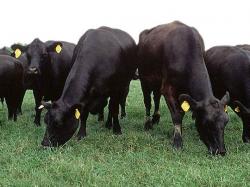Modern Beef Production Is 'Green'
October 6, 2011 | 4 min to read

Efficient cattlemen and women are a boon for the environment.
“I am absolutely not anti-grass-fed beef. There is a place for every single kind of system: grass-fed, grain-fed, local, organic and so on,” said Jude Capper, Washington State University animal scientist at the Certified Angus Beef LLC (CAB) Annual Conference last week. “What I am ‘anti’ is mis-marketing and the perceptions that are passed on to the consumer about what is and isn’t environmentally friendly.”
From farm publications and the Wall Street Journal to Cosmopolitan and mainstream women’s magazines, there is a constant stream of information about water, land and resource use. Beef is often held under the microscope, Capper told the crowd of more than 500 who gathered at the event in Sunriver, Ore.
“In every part of the world we’re going to face the issues of feeding more people on less land with fewer resources,” she said, citing estimates that by 2050 worldwide population will increase by 50% and we’ll need 70% more food to support that.
“On a global basis people are going to have greater incomes,” Capper said. “As people have more money they want more meat, more milk, more eggs.”
Today’s conversations about sustainability are well founded, she said, but some of the proposed solutions are not.
Take “Meatless Mondays” for example.
“Even if we all went meatless every Monday, if we only ate lentils and tofu and magically didn’t give off any methane ourselves, it’s going to cut our national carbon footprint by less than half a percent,” Capper said.
And then there are important considerations, like where would animal byproducts like leather, tallow and pharmaceuticals come from?
Instead, Capper suggested one proven method for reducing resource use: increase efficiency.
“If we can have our animals on the planet for fewer days before they’re harvested, in total we use less energy, less land and less water per unit of beef,” she said, pointing to examples over the years.
In 1977 it took five animals to produce the same pounds beef that it takes four animals to produce today.
“Beef yield over that time has gone up fairly consistently,” she said, noting carcasses can’t keep getting bigger because of consumer acceptance and processing challenges. “What we can do is improve productivity, improve growth rate.”
The efficiency gains from 1977 to 2010 amount to a 19-percentage-point reduction in feed use, a 12-point decrease in water needed and a 33-point drop in land required per pound (lb.) of beef.
“That’s not because ranchers and feedlot operators have implemented specific environmental technologies,” Capper said. “It’s because they’ve been doing what they do best, to improve productivity.”
Yet that story hasn’t caught on.
“The consumer often hears that grass-fed must be best,” she said. Capper and her research team analyzed and compared the environmental impact of three beef production systems: conventional, natural and grass-fed.
Looking at conventional, with its growth-enhancing technologies like implants and ionophores, versus natural production, cattle in the latter system take more days to finish.
“Animals that grow faster and weigh more cut the environmental impact,” she said. That’s magnified when comparing conventional to grass-fed, as average days from birth to harvest increase by 226 and carcass weights drop by 185 lb.
“To convert to an entirely grass-fed system, we’d need to more than double the number of the cows in the U.S. today just to maintain beef supply,” Capper said. Land use would increase by 131 million acres, equivalent to 75% of the area of Texas, and water use would skyrocket by 468 billion gallons.
Capper showed several highly publicized studies containing suspect assumptions about the modern beef industry.
“This is very dangerous because it’s put out there as fact in an international science magazine,” she said of one example. “Potentially, it turns consumers away from beef.”
Ranchers, stockers and feeders need to keep getting better, and talking about it.
Reducing mortality and morbidity is one step.
“It’s important to keep having healthier animals. They’re going to gain better and grow faster,” she said.
Reproduction is another.
“Only about 86% of cows have a live calf every year. If that was 90%, 95% or 99%, that would make a huge improvement in productivity,” Capper said. “If we improve our land, better grasses, better feed, those animals are going to grow faster.”
Good news is found in a recent study showing 94% of worldwide consumers either support or are neutral toward the use of technology in food production.
“Most consumers just want affordable, safe, nutritious food that tastes good,” she said.
To view Capper’s research visit http://wsu.academia.edu/JudeCapper/Papers. For more information on the Certified Angus Beef ® brand Annual Conference, go to www.certifiedangusbeef.com.
Source: Certified Angus Beef Brand
